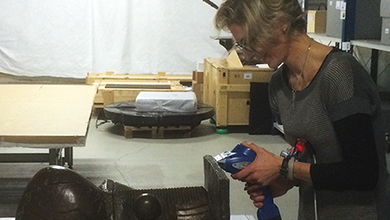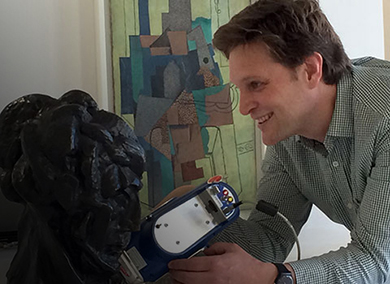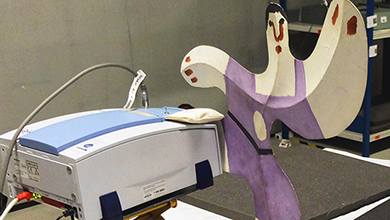Tracing 'Elemental Fingerprints' of Alloys in Pablo Picasso's Paris
The collaboration with Musée national Picasso-Paris allows insight into the artist's relationships with 20th-century French foundries
Musée national Picasso-Paris (MNPP) and the Center for Scientific Studies in the Arts have completed the first major material survey and study of the bronzes in the world-renowned MNPP collection using cutting-edge, portable instruments.
The international research team of scientists, art conservators and curators used the portable instruments and a robust database of alloy “fingerprints” to noninvasively analyze a priceless group of 39 bronzes cast between 1905 and 1959, as well as 11 painted sheet metal sculptures from the 1960s, in the Musée national Picasso-Paris’ collection.
 The researchers were able to trace five bronzes cast in Paris during World War II to the foundry of Émile Robecchi, a lesser-known collaborator of Picasso’s. They also discovered Robecchi’s alloy compositions varied significantly during 1941 and 1942, likely reflecting the challenging circumstances of the Nazi occupation of Paris. In their study of Picasso’s cast-iron sheet metal sculptures, the researchers are the first to report the use of silver for facial features in a work inspired by one of his wives.
The researchers were able to trace five bronzes cast in Paris during World War II to the foundry of Émile Robecchi, a lesser-known collaborator of Picasso’s. They also discovered Robecchi’s alloy compositions varied significantly during 1941 and 1942, likely reflecting the challenging circumstances of the Nazi occupation of Paris. In their study of Picasso’s cast-iron sheet metal sculptures, the researchers are the first to report the use of silver for facial features in a work inspired by one of his wives.
“Our project highlights the value of cutting-edge scientific tools and international collaborations in advancing discoveries in art,” said Francesca Casadio, the Grainger Executive Director of Conservation and Science at the Art Institute and co-director of the Center,. “It was exciting to partner with Virginie Perdrisot, curator of the Musée national Picasso-Paris, to unlock the material composition and technical details of Picasso’s creative process. We now can begin to write a new chapter in the history of this prolific giant of modern art.”
The Center team included Casadio and three scientists from Northwestern. Emeline Pouyet, a materials scientist and postdoctoral fellow, created the diagram of bronze compositions over which Picasso’s production could be mapped. With their portable instruments, which use X-ray fluorescence (XRF) spectrometry, the researchers could easily analyze the priceless objects in the museum galleries and in storage, without the need to move them.
 Using non-invasive analysis of elements at a work’s surface, Center researchers has amassed the world’s largest art database of alloy “fingerprints” for early 20th-century fine arts bronzes. More than a decade in the making, the database includes data on 350 works of art by the leading artists that came to Paris from all over the world to achieve the finest casts of their bronzes. This data is key to the Center’s “elemental fingerprinting” technique.
Using non-invasive analysis of elements at a work’s surface, Center researchers has amassed the world’s largest art database of alloy “fingerprints” for early 20th-century fine arts bronzes. More than a decade in the making, the database includes data on 350 works of art by the leading artists that came to Paris from all over the world to achieve the finest casts of their bronzes. This data is key to the Center’s “elemental fingerprinting” technique.
The researchers used this technique to analyze the alloys in the Picasso bronzes for clues about how, when and where they were cast. Scientific analysis of the metal alloys of the bronze sculptures, coupled with recently discovered archival information, revealed that five of Picasso’s 1941 and 1942 casts without a foundry mark were made by Robecchi’s foundry. One of these sculptures is Head of a Woman, in Profile (modeled 1931, cast 1941).
The study provides provenance for these works and helps define the activities of Picasso and the Robecchi foundry during war times. Picasso first modeled the works in the 1930s in plaster before working with the Robecchi foundry.
“In the context of increased material studies of Picasso’s painting practices, our study extends the potential of scientific investigations to the artist’s three-dimensional productions,” Pouyet said. “Material evidence from the sculptures themselves can be unlocked by scientific analysis for a deeper understanding of Picasso’s bronze sculpture-making process and the history of artists, dealers and foundrymen in the production of modern sculpture.”
The researchers also discovered that in this short two-year period during World War II, the composition of the alloy used by Robecchi varied significantly — possibly because of the scarcity of raw metals, German appropriation of non-ferrous metals for the war efforts and re-use of scrap metal from brass objects of ordinary use. This work was done in partnership with the Musée national Picasso-Paris staff and Clare Finn, a private conservator in London and an expert on the dynamics of fine arts castings during World War I and World War II.
Picasso made a relatively small number of sculptures (approximately 700, roughly one-sixth of his output in paintings) and issued few numbered editions of his bronzes, Casadio said. The circumstances of much of his early production as well as that of the sculptures cast during World War II have been unclear. Many of the bronzes analyzed by the Center team are unique casts.
 In its analysis of Picasso’s sheet metal sculptures, the research team is the first to discover the use of the precious metal silver to render the details of the hair, eyes and other facial features on the cast-iron sheet, polychrome sculpture titled Head of a Woman, cast in late 1962. The artist’s second wife, Jacqueline Roque, inspired the piece.
In its analysis of Picasso’s sheet metal sculptures, the research team is the first to discover the use of the precious metal silver to render the details of the hair, eyes and other facial features on the cast-iron sheet, polychrome sculpture titled Head of a Woman, cast in late 1962. The artist’s second wife, Jacqueline Roque, inspired the piece.
Analysis also sheds light on the productive relationship of Picasso with craftsmen in a workshop in the south of France. For this project, Ludovic Bellot-Gurlet, a molecular spectroscopist in Paris who has developed a mobile lab for paint and pigment analysis, worked side by side with Center scientists and their elemental analysis tools. They figuratively peeled back layers of paint to uncover what paintwork was done by Picasso to the sheet metal sculptures and what was applied by the workshop.
The project is part of a larger multi-institutional collaboration to scan works by Picasso, Auguste Rodin, Honoré-Victorin Daumier, and several other artists, to build a database of bronze alloys that can be used for comparison of foundry archives and other records of the material histories of these sculptures.
